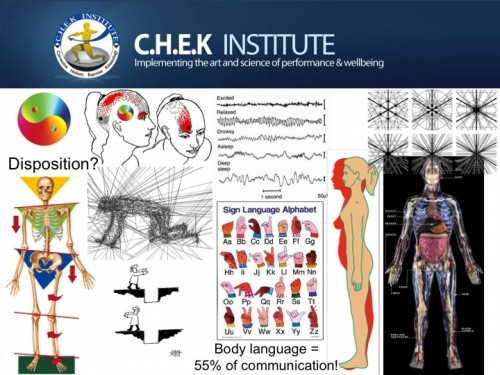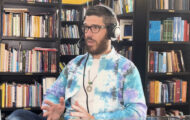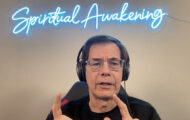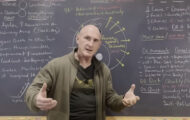THE CONFLICT CONNECTION
Good Day to all!
I had a busy, productive day yesterday. I hope you did too.
Today, I thought I’d share some of my observations as to how we unconsciously block ourselves from achieving our potential to experience the world as it really is.
THE CONFLICT CONNECTION
In the top left hand of my slide image, you see that tai-chi symbol. That symbol signifies that there are only two creative forces in the universe. They are the male force of yang (light = no-thing) and the female force of yin (matter = every-thing).
Yin is the force of desire; dark draws light into itself. Yang is the force of will; light illuminates what is in and transforms dark, or enlivens it to be expressed as. When viewed from an emotional perspective, tai-chi exemplifies that there are only two root emotions – Love (inclusion-connection) and fear (exclusion-separation).
The “S” line between yin and yang exemplifies Spirit. Spirit represents the power to transform. The power of yin to create yang and the power of yang to create yin.
The circle in which the tai-chi symbol is contained represents the Zero-force or Unconditional Love; The Zero-Force exemplifies that which is WHOLE.
These basics are essential to understand when we reach the realization that our life is largely of our own creation and that to change our circumstances, we must change ourselves. Because the Zero-Force is Unconditioned Potential, it can only manifest what you desire.
Many will read a comment like this and immediately begin to defend themselves. They often think thoughts like, “if that’s true, why do I hurt so much and not have what I want if it’s true that I can manifest what I desire?”
This is a legitimate question.
When we consider that current scientific investigations suggest that our conscious mind (ego-mind) only comprises about 8% of our conscious brain power, that means that 92% of our brain power is being used to run our subconscious mind; some of that 92% may also be totally unused potential.
What this means is that your ego (8%) may be choosing this or that, but the rest of you (92%) is choosing something else for reasons that most are largely unconscious of. The result is a person that states they want to loose weight, but doesn’t follow the program; A person that wants a better relationship, but doesn’t hear or respond to their own needs, nor the needs of their partner; a person that wants to get a better paying job, but can’t seem to find the energy or desire to make the shift, yet seems to have unlimited energy for complaining!
When we are born, we are very supple. We don’t suffer from joint restrictions, muscle aches and pains. Our bellies are soft and we laugh a lot. Our minds are not yet conditioned by ideas and beliefs. Because our minds are not yet conditioned, we have no impetus to act as a means of conforming.
Initially, our parents generally love us unconditionally. If you poop all over yourself, they clean it up with a smile and are just so enamored that they have created life together.
If you break something they deem “special”, they generally don’t fuss much because they know that you don’t know any better, and after all, their new baby is even more special than Dad’s stereo or trophy.
Sooner or later though, the parents begin imposing conditions on their child. Some conditions are absolutely necessary for the child’s safety. It is necessary to condition a child to the dangers of sharp objects, fire, and the fact that some animals scratch and bite. It is necessary for a child to understand the nature of gravity, for a fall down a staircase can be fatal.
These conditions are generally met by parents out of love and the willingness to preserve the child’s life. Such conditioning represents survival training for anyone with a body on the earth plane of existence. Any child not given such conditioning would be perceived to not have been loved, not parented effectively.
When the conditioning shifts from essential conditioning to nonessential conditioning, the conditioning still functions in the mind of the child.
Now, we go from “no no Johnny, don’t touch the stove or you will get burned”, to “BAD BOY JOHNY, I TOLD YOU A THOUSAND TIMES NOT TO GO NEAR THE STOVE!” Such conditioning is generally followed by progressive layers of conditioning.
Soon, when Johnny approaches the stove, he’s not only being programmed to believe that the stove is hot, he also being told he is a bad boy. He is now receiving messages that say, “when I go toward the stove, I’m BAD and mommy and daddy don’t love (want) me.
Sadly, many children soon find themselves being conditioned by force and/or violence; the loud voice is now followed by a slap on the hand or something similar.
Now, Johnny is caught between unbridled curiosity and the desire for parental love. He naturally has an affinity for both, because both conditioning and parental love are essential to growth and survival. He is confused because when he follows his curiosity, he’s feeling the joy of interaction.
Yet, when he seeks to create that same joy with other objects, his curiosity leads to a moment of joy followed by what may become a lifetime of painful self-reflection; I’m never going to be a good boy because I’m always in trouble and mom and dad told me I’m a “bad boy”!
When we are assaulted physically, emotionally or mentally, out of our urge to survive, we create defenses. You don’t have to yell at, or hit a child or an animal many times before it begins to read your body language.
As my diagram shows, 55% of all communications come via body language, not by spoken word.
The more challenging it is for a child to survive their environment due to painful experiences, the more hyper-aware of subtle environmental cues it becomes. The child knows the look on mom’s or dad’s face and body language that now predicts events to come.
Soon, without any conscious effort or awareness at all, the child armors itself adequately to survive the threatening environment it has come to know and expect; “expect” being the operative word or verb here.
The Body Never Lies!
How we come to perceive, expect and respond represents our disposition.
If we tend to be grumpy and uninterested, naturally may be perceived by others as grumpy and uninterested. If after years of being that way, all the sudden your father acts happy and interested, the child doesn’t stop projecting the probability that at any moment, dad is likely to become grumpy and uninterested.
In fact, such a radical shift in disposition can, and often does confuse a child or others in relationship to such people. They become afraid to believe that dad is happy and interested to the degree that such shifts in dad’s disposition don’t turn out to be authentic.
Now, the child learns that when people appear happy and interested, it’s just a matter of a few moments before the other dad returns. They learn, often subconsciously, that to love the happy, interested dad is to invite the grumpy uninterested dad back into their life.
To love the grumpy uninterested dad seems to incite criticism and rejection because to love someone means to “include” them; dad doesn’t want to be “included”, he wants to pretend the responsibilities of being a dad don’t exist when he gets home because he’s tired.
Now, regardless of which dad (or mom) walks in the room, Johnny’s body-mind has already calculated the probability that he will have to defend himself. He wants to love, but is afraid to. He wants to be loved, but is afraid to be loved.
If Johnny’s reaction to being slapped and criticized is to withdraw and protect, Johnny’s posture will reflect movement toward the fetal position and will include hardness or tightening of the flexor surface (front) of his body.
If Johnny determines that to be loved, he must be willing to jump at mom and dad’s commands and do anything they ask, there is likely to be over-excitation of the extensor muscles. This tends to produce a rigid, upright posture.
This Johnny is hyper-alert to the probability that if he can serve the other effectively (as “they” want), then he will be loved and safety is more likely. This Johnny is likely to burn himself out attempting to get love from others, even when it hurts.
The other Johnny is likely to burn himself in trying to avoid interactions with others; after all, based on a lifetime of experience, the probability is high that happiness and interest will soon turn to grumpy disinterest, so why bother!
Mind-Body Reality
The reality is that there is no separation between mind and body.
When people sleep and dream, their body acts out the dream. I know what kind of dreams my wife is having by what her body is doing. Since she loves to dream about outdoor activities like climbing mountains, she’s often taking large lunging steps or moving her feet quickly as though hopping rocks to cross a stream.
We know this to be true scientifically because when we hook someone up to an electroencephalogram that measures brain-wave activity, if we also have them hooked to an electromyogram that measures muscle activity, we can easily see that thought-action is converted to muscle-action in the body.
If as children we learn that it is unsafe to create and experience our dreams, then naturally our focus shifts to surviving their dreams. Therefore, our body begins to reflect all the body-mind projections we’ve created out of necessity of attempting to create safety for ourselves.
If we’ve learned that the people that (should) love us the most are dangerous, and they are the people we’ve spent the most time around and learned the most from, then naturally, we expect the rest of the people in the world to be similar.
If we get bitten by a dog as a child and it both hurt and scared us, we naturally suspect there is a great probability that all dogs may hurt us.
Such a person, without realizing they are doing it, assumes a defense posture as they approach a dog. They may truly desire to connect with, to share love with the dog in front of them, yet, the dog sees a person approaching them as though they would see a dog approaching with teeth out and hair raised.
When a dog sees you approaching in defense mode, it inherently knows to trust what it “sees” more than it trusts what it hears. Many animals (including humans) use sound to bait their prey.
Where you have been hurt, you become closed to prevent re-exposure.
Now, if you look at my slide image, you see a body on its hands and knees that is full of probability lines. Where you see darker black in their body, you see holding patterns. These holding patterns penetrate every tissue that is involved in the defense-express pattern tied to the perception that created them.
Each organ in our body is responsible for holding and creating specific emotional responses, not just the physical products of that organ as most westerners have come to believe; your heart isn’t just a pump, it’s a love-organ. This is because the organs both have to survive, and know how to function in a battle to keep you alive.
Therefore, to the degree that you’ve had to repeatedly liberate stress hormones, sugars and fats in preparation to fight or flight, your pancreas and adrenal glands are put into action whenever you perceive you are about to encounter a threat.
Each of the lines then, may be perceived as lines of feeling that are attached to eyes looking and ears feeling for the information needed to confirm the “projection of their own probability”.
Below that image you see a cartoon of a person walking toward a ditch. To get where they want to go, they must jump the ditch. The ditch here represents an obstacle to getting what they want (Love). Even though they could easily jump the ditch, or simply climb down into it and walk across to the other side, the voice of the wounded child determines that the probability of getting what you want is either:
A. Slim, or
B. It will transform into pain, even if it begins as happy interest.
The result is vacillation.
Walk to the edge, think about it and scare yourself. Turn around, walk away, and disappoint your self because you aren’t getting what you want again.
This kind of behavior is the origin of anxiety and/or nervousness.
Anxiety and nervousness commonly become such people’s background state. Sadly, they become afraid to relax because to do so is to remove your armor and leave yourself open to being hurt again!
Sadly, such people often meet someone they feel they really love and want to be with, yet, to the very degree they find comfort with such people, without really knowing why, they become nervous, even scared. They are paradoxically alone with/in love!
This is very sad, but as you will see, the wise ones know that when they eventually unwrap the gift, their pain and fear becomes the seed of love and beauty in their life.
HAVE A DREAM
The process I’ve just described is, as I’m sure most of you are aware, very common at large in most cultures. Therein lies the benefit.
First, to survive any environment, we must become aware of what the environment includes.
If you have a sports car and someone invites you to go out and explore trails, without realizing what you are opting for, you are likely to show up driving your sports car.
If you have to drive down the trail to the meeting point, you may ruin your car to get there.
Your friend may really find it funny that you drove your sports car, not a four-wheel drive because they were aware of the requirements of the chosen environment and expected you would be as well.
Having participated in the creation of their dream before, they were already aware of what equipment is needed to experience their chosen dream. They have participated in the process of creating that dream before and know how to do it for themselves now.
Having a dream establishes both motive and direction.
Looking at the girl who’s poor (defense) posture is depicted in red (in my diagram), we see a girl who may have a dream of looking and feeling better. Her dream holds the vision (direction) she must move in to experience the dream.
To get from where you are, to where you desire to be is the process of dream creation.
The green outline of her in upright posture, balanced between desire and will, protection and expression exemplifies the end means – to choose look and feel good inside is the only assurance such a reality can exist outside.
Because she is very aware of what she doesn’t want, she now desires, and therefore focuses on what she does want. Her thoughts or probabilities now become coherent. She’s coherent to the degree that she is clear about what she is creating and expresses her actions accordingly.
As we become clear or coherent with our stated dream and enter into the process, we naturally begin to exclude thought-actions that aren’t congruent with the dream to the degree that we are authentically ready to experience our dream.
Now the mind begins to project coherent lines of probability, as exemplified above the body with organs on the far right of my slide image.
As we practice acts of love to create our dream and experience ourselves in love, we become more and more aware of our ability to change. We become more and more comfortable with the awareness that we can create love in our lives.
With each successive experience, we become more and more self-empowered.
Now, when we hurt, the pain isn’t the focus of our day. The pain is just another of the many obstacles that we learn to transform as a natural part of the process of creating any dream.
Where we once held what we don’t want or were afraid of as our primary impetus to action, we now hold what we want and are willing to experience as our impetus to action.
Inevitably, we find with experience, that we must overcome our old, fear-based thinking; when we have done that in the past as a means of creating our dreams, it has largely been successful to the degree that we were committed to experiencing that dream.
We eventually realize that we actually limit ourselves far more than others limit us.
As we become more and more coherent, our body and mind become more congruent with each other.
As we feel more joy and freedom in the creation of our dreams, we become progressively more and more open to any and all experiences related to creating and living the dream. These often include painful challenges with people, places and things.
The difference is that now that we don’t have to do what mommy or daddy wants, we can create what we want.
Because we have a north star, a compass bearing to guide us to our dream, the challenges that once comprised the primary (survival) focus of our day only become “detours”.
When we are sure where we want to get in our car, if the map doesn’t reflect the territory, we simply find a way around the obstruction and no amount of complaining or being nervous is going to improve our ability to get where our dream is trying to take us.
In fact, it can have the effect of making it even more exciting to have arrived.
When a person like this needs help from a therapist like me, they respond very quickly to coaching and therapy. This is because we aren’t removing what they think they are. We are removing what isn’t part of their dream, and that is easy for anyone who is clear about what they want to let go of.
After someone goes through this process enough times, they naturally learn to see and feel the body-mind of other less effective dreamers.
They learn to have empathy and compassion for them. Empathy and compassion can only come by way of experience.
Experience is the chief ingredient of “wisdom”. When we’ve created effectively enough to enjoy our life and look back on our pains and problems with a sense of humor and see how they actually served us, we can easily see ourselves in others.
Because we’ve had the pain of separations and the joy of creations, we find it easier to be clear because we are quite sure now, what separation experiences produce, and what conscious creation experiences produce.
Anyone that has truly experienced love never wishes anything other for anyone, even their so-called enemy; they know that if their so-called enemy could feel the love they do, they wouldn’t be an enemy any more.
They know that in love, this enemy would not be in defense mode. They would be happy and happy people don’t start wars!
This is what it means when Jesus is reported to have said, “Love your enemies”. He was implying that most “enemies” are wounded people. Wounded people don’t generally heal in battle. They heal when the environment is safe to heal.
Therefore, paradoxically, when we hate or resist our enemy, we reassure their ego mind that indeed, you are a threat.
When we do our best to love our enemy by finding what their unmet need is, we can determine how to love them safely and effectively.
Some people are best loved via long distance phone calls. Some are best loved with email or a short note on a card. Some are safer to love in our prayers.
How you choose to love the enemy within largely determines how you love the enemy perceived to be outside you.
When you are clear as to your motive, your thought-energy produces the thought-forms that exemplify that very intention.
Since you are connected directly to the so-called enemy through body-mind association, however you genuinely love the enemy represented in self or other becomes a healing force.
You will find that learning to love at a distance is often the best way to close the gap between self and other. As that gap naturally closes, we see prayers becoming cards. Cards then become emails. Emails then become calls. Calls then become meetings. Meetings become celebrations. Celebrations become experiences of love.
Being wise, we too remember how our search for love often began as painful. Being wise, we too remember that beliefs can condition us to see what isn’t there.
Being wise, we know that our intention, our dream creates coherence to the degree that our actions are congruent with our stated direction or intentions.
Being wise, we become patient. Being patient, we don’t need to push. Not needing to push, we are open to feeling. Being open to feeling, we trust our sense of knowing. Trusting our sense of knowing, we always feel safe.
We know that when Love is our dream and our intention, there are no immovable objects, there are just the natural challenges to creating and sharing our dreams.
When we realize that love is more infectious and fulfilling that pain or separation, it becomes our way of being and sharing.
From this place, anyone that genuinely looks back on their life, their childhood realizes that as strange as it may seem, they got just what they needed to learn to take responsibility for their own creations, their own dreams. They got just what they needed to learn how the body reacts to the mind.
How one can heal from most anything if their dream is bigger and more beautiful than their pains. In the end, we learn that all our so-called conflicts taught us to be sensitive to the unmet needs of others.
With that awareness, we now know how to create connection with all those challenging people in our lives that need a loving example the most.
We are safe
We are whole
We are home.
Love and chi,
Paul Chek















Find me on the web